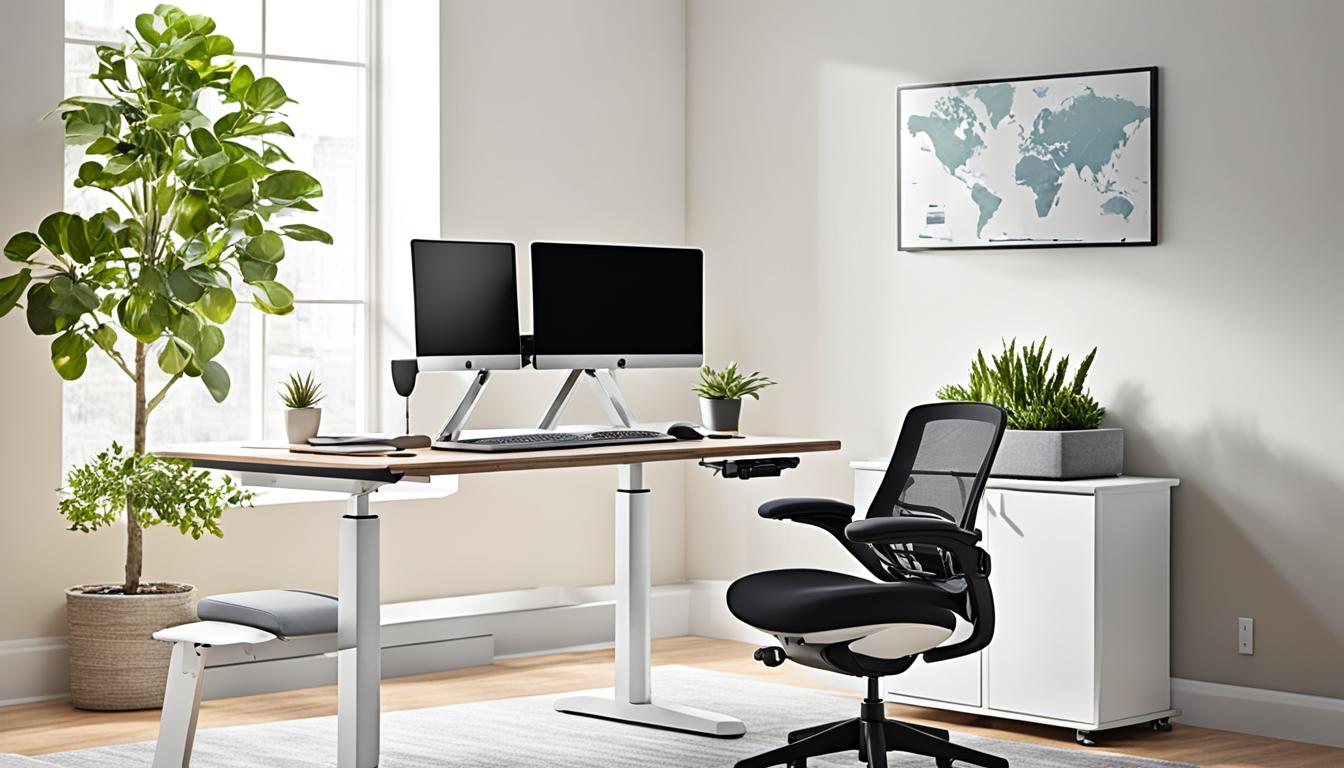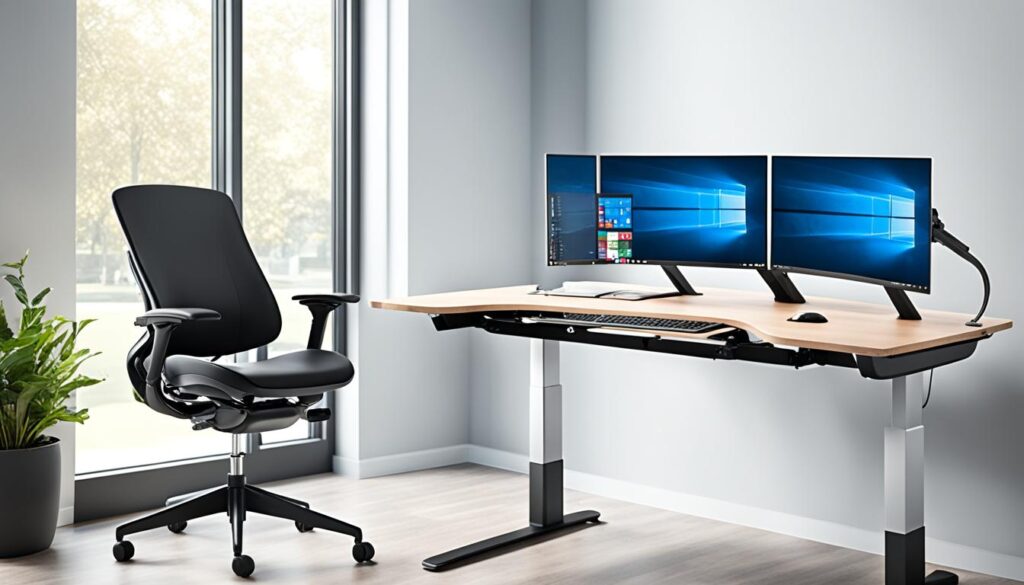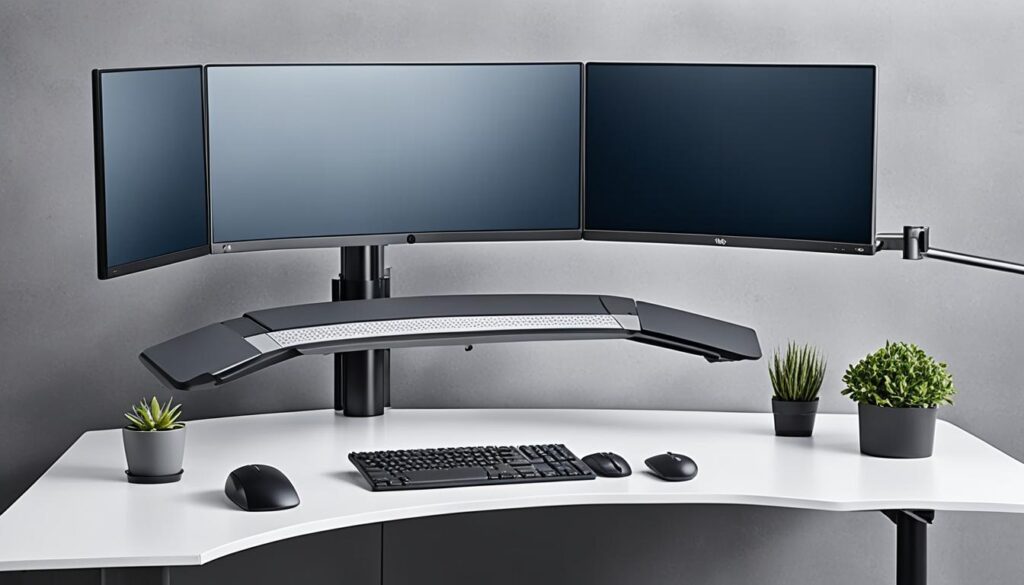Transform Your Workspace with Ergonomic Desk Setup

Are you tired of dealing with discomfort and fatigue at your desk? Do you often find yourself hunching over, straining your eyes, or experiencing back pain after hours of work? It’s time to rethink your workspace and transform it into an ergonomic haven that supports your well-being and enhances your productivity.
An ergonomic desk setup is the key to creating a workspace that aligns with your body’s natural movements and promotes proper posture. By making a few adjustments and following the principles of ergonomic design, you can revolutionize your workspace and say goodbye to discomfort and fatigue.
Key Takeaways:
- An ergonomic desk setup can greatly improve your comfort and productivity.
- By following the principles of ergonomic design, you can create a workspace that supports your body.
- Elements such as lighting, chair, and monitor placement play a significant role in optimizing your desk setup.
- An ergonomic desk setup offers numerous benefits, including preventing musculoskeletal disorders and reducing eye strain and fatigue.
- There are various ergonomic accessories available that can enhance your desk setup and promote a healthy posture.
An Ergonomic Desk Setup at a Glance
Creating an ergonomic workspace is crucial for your comfort and productivity. An ergonomic desk setup incorporates various elements that contribute to a productive and comfortable workspace. Let’s dive into the key components that you should consider:
Proper Lighting
Good lighting is essential for reducing eye strain and maintaining focus. Ensure that your desk area is well-lit and position your monitor to minimize glare. Consider using task lighting or adjustable desk lamps to provide adequate illumination.
Indoor Plants for Fatigue Reduction
Adding indoor plants to your workspace can improve air quality and reduce fatigue. Plants have been shown to enhance mood and provide a soothing environment, boosting your overall well-being and productivity.
Comfortable Temperature
Maintaining a comfortable temperature in your office is crucial for optimal performance. Adjust the temperature to a level that suits your preference and avoids distractions caused by extreme heat or cold.
Managing Noise Distractions
Noise distractions can disrupt your focus and productivity. Consider using noise-canceling headphones or a white noise machine to minimize the impact of external noises.
Ergonomic Chair with Lumbar Support
Your chair plays a vital role in your ergonomic desk setup. Choose an ergonomic chair that provides proper lumbar support to maintain a healthy posture and reduce the risk of back pain.
Desk and Monitor Placement
Position your desk at a height that allows your arms to rest comfortably on the surface, with your elbows at a 90-degree angle. Adjust your monitor to eye level to prevent neck and eye strain. An adjustable monitor stand or arm can help achieve the ideal position.
Other Considerations
Additional ergonomic office equipment, such as a keyboard and mouse with ergonomic designs, can further enhance your setup. Cable management solutions can keep your workspace organized and free from hazards, while a footrest can provide additional support and comfort.
Summary
Creating an ergonomic desk setup involves a holistic approach that addresses lighting, indoor plants, temperature, noise distractions, ergonomic chairs, and proper desk and monitor placement. By optimizing these elements, you can transform your workspace into a productive and comfortable environment that supports your well-being and enhances your productivity.
The Essential Elements of a Productive Workspace
In addition to creating a well-designed ergonomic desk setup, there are several other elements that contribute to a productive and efficient workspace. These elements include:
1. Quality Lighting
The quality of lighting in your office is essential for creating a productive environment. Natural light is ideal, so position your desk near a window if possible. If natural light is limited, incorporate task lighting with adjustable brightness options to reduce eye strain and enhance focus.
2. Indoor Plants
Indoor plants not only add a touch of greenery to your workspace but also offer several benefits. They improve air quality, increase oxygen levels, and help reduce stress and fatigue. Incorporate plants such as peace lilies, snake plants, or pothos to improve mood and overall well-being.
3. Optimal Temperature
The temperature of your workspace can significantly impact productivity. It’s important to maintain a comfortable temperature that suits your preferences. Aim for a temperature between 68-72°F (20-22°C) to create an ideal working environment.
4. Noise Management
Noise distractions can disrupt focus and decrease productivity. Consider using noise-cancelling headphones or playing background music to drown out external sounds. Alternatively, you can have a white noise machine or a fan that provides gentle ambient noise to mask distracting sounds.
5. Personalization
Make your workspace your own by adding personal touches, such as photos or artwork, that inspire and motivate you. Creating a space that reflects your personality can enhance your overall well-being and ignite creativity.
By incorporating these elements into your workspace, you can create a productive and inspiring environment that promotes focus, creativity, and overall well-being.

How to Create an Ergonomic Desk Setup
Creating an ergonomic desk setup involves careful consideration of the placement of your chair, desk, monitor, and other equipment. By optimizing your workspace, you can enhance your comfort and productivity. Follow these steps to create an ergonomic desk setup that is tailored to your needs:
- Choose an ergonomic chair: Invest in a chair that provides proper lumbar support and allows you to sit with good posture. Look for adjustable features like seat height, armrests, and backrest angle to ensure a customized fit.
- Adjust your desk height: Position your desk at a height where your arms are parallel to the floor when typing. This allows for a comfortable typing posture and minimizes strain on your wrists and shoulders.
- Set up your monitor: Position your monitor directly in front of you at eye level to prevent neck strain and eye fatigue. Use a monitor stand or adjust the height of your monitor to achieve the desired position.
- Arrange your keyboard and mouse: Place your keyboard and mouse at a distance that allows your elbows to rest comfortably at your sides and your wrists to remain straight. Consider using an ergonomic keyboard and mouse to reduce the risk of repetitive strain injuries.
- Organize your cables: Keep cables and cords neatly organized to avoid trip hazards and create a clutter-free workspace. Consider using cable management solutions such as cable clips or cable sleeves to keep things tidy.
By following these guidelines, you can create an ergonomic desk setup that promotes proper posture, reduces discomfort, and maximizes your productivity.

The Benefits of an Ergonomic Desk Setup
An ergonomic desk setup offers numerous benefits. It can help prevent musculoskeletal disorders, such as back pain and repetitive strain injuries, by promoting proper posture and reducing strain on the body. A well-designed workspace can also improve productivity and focus, as well as reduce the risk of eye strain and fatigue. Additionally, an ergonomic desk setup contributes to overall well-being and comfort, allowing you to work for longer periods without discomfort or physical stress.
Preventing Musculoskeletal Disorders
An ergonomic desk setup is designed to support your body and minimize the risk of musculoskeletal disorders. By using ergonomic office equipment, such as an adjustable chair and an ergonomically designed keyboard and mouse, you can maintain a neutral and comfortable posture while working. This helps to reduce the strain on your muscles, joints, and tendons, lowering the risk of conditions like back pain, carpal tunnel syndrome, and tendonitis.
Improving Productivity and Focus
An ergonomic desk setup can significantly improve your productivity and focus. When you are in a comfortable and well-supported position, you can concentrate better on your tasks without being distracted by discomfort or pain. Proper positioning of your monitor at eye level and reducing glare on the screen can also enhance your visual comfort, allowing you to work for longer periods without experiencing eye strain or fatigue.
Enhancing Overall Well-being and Comfort
A well-designed ergonomic desk setup contributes to your overall well-being and comfort. It promotes healthy posture, which can prevent long-term musculoskeletal issues and promote better physical health. Additionally, ergonomic office equipment, such as lumbar support chairs, footrests, and adjustable desks, allows you to customize your workspace according to your individual needs, ensuring that you can work comfortably for extended periods without experiencing discomfort or physical stress.
Incorporating an ergonomic desk setup into your workspace is an investment in your health, productivity, and overall well-being. By creating a workspace that supports your body and minimizes strain, you can enjoy the many benefits it offers. Take the time to evaluate your current setup and make adjustments as necessary to optimize your ergonomic desk setup.
| Benefits of an Ergonomic Desk Setup |
|---|
| Prevents musculoskeletal disorders |
| Improves productivity and focus |
| Enhances overall well-being and comfort |

Essential Ergonomic Accessories for Your Desk Setup
To enhance your ergonomic desk setup, there are various accessories that can be beneficial. These accessories can further optimize your workspace and ensure that you are maintaining a healthy posture and ergonomic position throughout the day.
Ergonomic Monitor Arms or Stands
One essential accessory for your ergonomic desk setup is a monitor arm or stand. This accessory allows you to position your monitor at eye level, reducing strain on your neck and preventing eye fatigue. By adjusting the height and angle of your monitor, you can maintain a comfortable viewing position, promoting better productivity and reducing the risk of musculoskeletal issues.
Keyboard Trays for Proper Height and Wrist Support
Another accessory that can greatly improve your ergonomic desk setup is a keyboard tray. These trays can be mounted underneath your desk and adjusted to the correct height, ensuring that your wrists are in a neutral position while typing. By providing proper wrist support, keyboard trays help prevent repetitive strain injuries and promote overall comfort during long hours of work.
Ergonomic Keyboards and Mice
Incorporating ergonomic keyboards and mice into your desk setup can also make a significant difference in your comfort and efficiency. Ergonomic keyboards are designed with split or curved layouts, allowing for a more natural hand and wrist position. Similarly, ergonomic mice are shaped to fit the contours of your hand, reducing strain and providing better control. These accessories can minimize the risk of repetitive strain injuries and improve your overall typing and pointing experience.
Backrests and Footrests for Added Comfort and Support
To further enhance your ergonomic desk setup, consider incorporating backrests and footrests. A supportive backrest can help maintain proper spinal alignment and reduce stress on your back during long periods of sitting. Footrests can improve circulation, reduce lower back fatigue, and provide additional support for your feet. These accessories contribute to a more comfortable and ergonomic workspace, minimizing the risk of discomfort and promoting better posture.

| Accessory | Benefits |
|---|---|
| Ergonomic Monitor Arms or Stands | Position your monitor at eye level, reduce strain on neck and eyes, optimize viewing position |
| Keyboard Trays | Proper keyboard height, wrist support, prevent repetitive strain injuries |
| Ergonomic Keyboards and Mice | Natural hand and wrist position, reduce strain, improve typing and pointing experience |
| Backrests and Footrests | Support proper spinal alignment, reduce back fatigue, improve circulation, provide additional foot support |
Conclusion
An ergonomic desk setup is your key to creating a comfortable and productive workspace. By incorporating the principles of ergonomics and utilizing ergonomic office equipment, you can optimize your desk setup and reduce the risk of discomfort and injury.
A well-designed and ergonomic workspace not only improves your posture but also enhances your productivity and promotes overall well-being. With the right adjustments and ergonomic desk setup guide recommendations, you can transform your workspace into an environment that supports your work life.
Take the time to evaluate your current setup and make the necessary adjustments. Consider the benefits of an ergonomic desk setup, such as reducing the risk of musculoskeletal disorders, preventing eye strain and fatigue, and increasing your overall comfort. Invest in ergonomic office equipment, such as an ergonomic desk chair and accessories like monitor arms and keyboard trays, to further enhance your setup.
Remember, an ergonomic desk setup is more than just a trendy concept. It is a practical solution that can significantly impact your well-being and performance. So, prioritize your health and productivity by creating an ergonomic desk setup that suits your needs and supports your work life.






